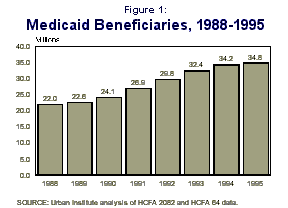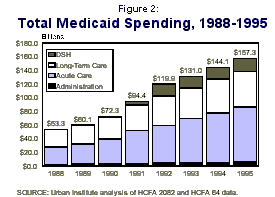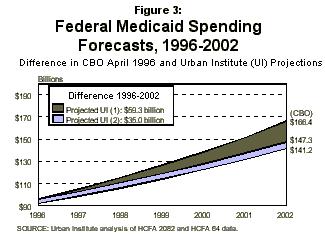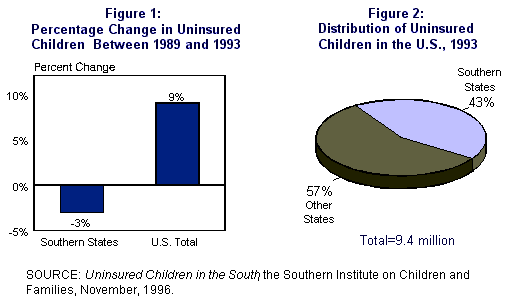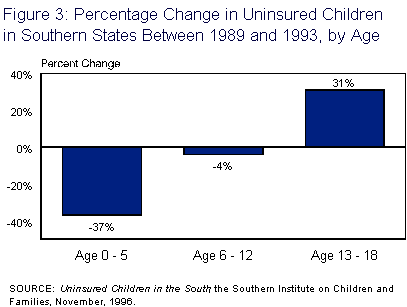Where is Medicaid Spending Headed?
Enrollment
Another important factor is that Medicaid enrollment increases slowed substantially. After increasing by 7.9 percent annually between 1988 and 1992, enrollment growth slowed to 5.3 percent per year in the following three years (Table 2). Table 3 shows that the rate of growth in enrollment of Medicaid beneficiaries slowed between 1991 and 1995. Enrollment growth increased by 11 percent in 1992 but by only 1.8 percent in 1995. Enrollment growth among the aged slowed from 7.2 percent in 1992 to 1.2 percent in 1995. In 1995 the blind and disabled grew by 6.8 percent, a substantial decrease from the 10.7 percent seen in 1992. Finally, among adults and children, Medicaid growth increased by 11.7 percent in 1992 and 9.1 percent in 1993, but by only 0.8 percent in 1995.
Enrollment growth slowed for a number of reasons. First, there was a decline in AFDC rolls in recent years following an improved economy, as well as efforts in many states to reduce welfare program participation primarily through tougher work requirements. Second, growth in coverage for pregnant women and children has also declined. One reason for the faster growth in the early 1990’s was the relatively new coverage mandates affecting pregnant women and children. This program now has relatively high participation, and growth in this group has slowed considerably as would be expected.
Third, the growth in the blind and disabled population has also begun to slow down. Much of the growth in the early 1990’s was due to court decisions and regulatory changes that resulted in dramatic increases in enrollment of disabled children. Since the initial burst of new enrollment, growth rates in enrollment of the disabled population in the last three years in Medicaid has slowed. Program data reveal that the growth in the SSI disabled, at more than 10 percent per year in the early 1990’s, fell to about 5.8 percent in 1995.9 Finally, there has also been a slowdown in growth among the elderly. Much of the rapid enrollment increase among the elderly in recent years was due to the introduction of the QMB program. The program experienced rapid growth initially, but again as would be expected in any new program, increases in participation have slowed. Moreover, the number of elderly receiving cash assistance through SSI continues to decline.
Spending per Enrollee
Another set of causes of lower Medicaid growth rates is due to controls on spending per enrollee. Growth in spending per enrollee fell from 9.5 percent to 4.9 percent per year. It is too soon to know why this has happened but there seem to be a number of possible reasons. The first is the rapid growth in managed care which seems to be achieving at least short term savings in several states. Initially, participation in Medicaid managed care was voluntary on the part of the enrollee. The evidence on the success of these voluntary programs in containing costs is mixed in part because the favorable selection into managed care plans makes it difficult to measure savings.10 Recently, there has also been a rapid expansion of mandatory managed care through both Section 1915(b) “Freedom of Choice” and Section 1115 “Research and Demonstrations” waiver programs. Managed care enrollment has growth dramatically from 3.6 million beneficiaries in 1992 to 11.6 million-one third of Medicaid enrollment-in 1995. The Section 1915(b) waivers are more numerous, but are typically limited to a geographic area in a state. Managed care can be mandatory for eligible beneficiaries residing in that area. Thirty three states have obtained Section 1915(b) waivers for managed care.
The Section 1115 waivers permit states to move substantially further in enrolling Medicaid beneficiaries in managed care.11 The most prominent of the early Section 1115 waiver programs have been in Hawaii, Oregon, and Tennessee. These programs often extend coverage to uninsured people in the state up to higher income levels than typically included in Medicaid. Hawaii essentially extended coverage to all uninsured persons (excluding the disabled) below 300 percent of the federal poverty line. Oregon extended coverage to all non-disabled individuals below 100 percent of poverty. Tennessee embarked on a major expansion with the intent of covering all of the uninsured below 400 percent of the poverty line. Expansions by these states were financed through savings derived from capitated payments to managed care plans and the use of the state’s DSH payments.
Today, 15 states have received HCFA approval for Section 1115 waiver programs, and 11 have implemented these programs.12 One major change in the evolution of Section 1115 waiver programs is that they have moved away from expansion of eligibility and consolidation of existing non-Medicaid programs that finance health care for the poor. Instead, in later waiver programs, the major emphasis is less on eligibility expansion and more on achieving savings through managed care.
The growth of managed care and the changes in federal DSH policy cannot explain all or even most of the slowdown in Medicaid spending growth. For example, the growth in spending per enrollee fell more for the elderly and blind and disabled than for families (Table 2), the population most affected by the growth in managed care. One explanation is the drop in average annual medical price inflation from 8.2 percent from 1988 to 1992, to 5.1 percent from 1992 to 1995. States also appear to have successfully adopted other policies to limit expenditure growth, particularly for long-term care (Table 1). Many states also seem less willing to use Medicaid as the vehicle through which to funnel state spending for a wide range of social service programs. While the basic financial incentives in Medicaid have not been changed and a return to Medicaid maximization efforts could reappear, for the moment these efforts appear to have stalled.
CBO’s April 1996 Baseline
In their April 1996 baseline estimate, CBO forecast an average annual increase in federal Medicaid spending of 9.7 percent between 1996 and 2002. Medicaid enrollment would rise from 36.8 million to 43.1 million, and program spending would increase from $95.7 billion to $166.4 billion. In August 1996, the CBO issued a partially revised (total spending only) Medicaid spending baseline, where projected 1996 spending was reduced by approximately $4 billion. The CBO is currently considering a substantial revision to this baseline.
We use the April 1996 CBO baseline as a reference point, however, given that it was the most recently available set of detailed CBO estimates. Because the growth rates for 1997 to 2002 were unchanged, a lower level of 1996 spending does not significantly affect our conclusions. However, the reader should bear in mind that the absolute levels in CBO baseline and in our alternative simulation are overstated.
As shown in Table 4, the number of beneficiaries were assumed to grow by 2.7 percent per year and spending on benefits by 10.2 percent per year between 1996 and 2002. The CBO assumed a 5.0 percent average annual growth in DSH payments each year and a 10.2 percent annual growth in administrative costs. The CBO forecast of beneficiary growth represented an assumption of slower enrollment growth than in past periods. Similarly, spending per beneficiary was also assumed to be lower (7.3 percent per year). The growth in DSH payments represented a substantially slower growth than experienced from 1988 to 1992 because of federal legislation in 1991 and 1993 affecting these expenditures.
Why Medicaid Spending Growth Will Remain Slow in the Near Future
There are many reasons to believe that Medicaid spending growth will be even less than that under the current CBO baseline. First, the growth in enrollment of persons living in low-income families is likely to be below rates seen in the early 1990’s. As shown in Table 3, there have been sharp declines in the growth of adults and children receiving Medicaid. The mandated coverage expansions of pregnant women and children have relatively high participation; continued rapid growth in this group should not be expected apart from the incremental inclusion of poor children under age 18. In addition, there has been a decline in AFDC rolls in recent years in part because of the improved economy as well as the widespread efforts to reduce welfare program participation. Recent welfare reform legislation will also probably depress Medicaid enrollment. While current rules for Medicaid eligibility largely remain, the work requirements and the establishment of separate enrollment procedures for the Temporary Assistance to Needy Families (TANF) program and for Medicaid are likely to result in lower participation rates. CBO projected growth in enrollment of adults and children to be 2.4 percent per year between 1996 and 2002 (Table 4). This is more than double the likely growth in the poverty population and seems high given the recent experience.
Second, the current CBO forecast assumes slower growth in enrollment than actually experienced in the early 1990’s, but their projections are higher than experienced in the most recent year. For example, the QMB program experienced rapid growth initially, but as would be expected in any new program increases in participation have slowed. Moreover, the number of elderly receiving cash assistance through SSI and, thus, Medicaid coverage continues to decline. As shown in Table 3, enrollment growth of the elderly is declining and grew by less than 1.0 percent in 1995. Enrollment of the elderly in Medicaid should continue to grow faster than the growth of the elderly population (about 1.8 percent). However, CBO assumed it would increase by 2.8 percent between 1996 and 2002, significantly faster than growth in the elderly population.
Third, the growth among the blind and disabled is also likely to slow. As shown in Table 3, there has been a slowdown in enrollment of the disabled in Medicaid in the last three years following dramatic increases due to court decision in the early 1990’s. Program data reveal that the growth in the SSI disabled between 1994 and 1995 fell to about 5.8 percent in 1995 and increased by only 2.1 percent in the first half of 1996.13CBO estimated that the disabled would grow by only 3.8 percent per year between 1996 and 2002 (Table 4), a seemingly modest growth rate but one that still may be too high, given recent trends. Recent legislation affecting SSI eligibility for disabled children and those with substance abuse problems will also lower enrollment rates.
Fourth, the current CBO forecast does not seem to adequately account for reductions in the growth in spending per enrollee that have occurred in the 1992 to 1995 period and are likely to continue. CBO assumes that federal spending per beneficiary will grow by 7.4 percent per year, about 4.6 percentage points faster than the rate of general inflation. This is higher than recent experience; for example, spending per beneficiary grew by 5.0 percent between 1992 and 1995. The CBO forecast for increased spending per beneficiary for the elderly and disabled was well above that of the previous four years. Much of the recent growth is among QMBs and modestly disabled children. Since both of these groups that are growing the fastest also have relatively low expenditures, this seems unwarranted. CBO assumes that long-term care spending per beneficiary will increase by about 6.3 percent annually (not shown). Finally, CBO assumes spending on acute care services per beneficiary would grow at about 7.5 percent between 1996 and 2002 (not shown). This is faster than most states are reportedly experiencing through the increased use of managed care, reductions in benefits, and other aggressive cost containment policies.
Finally, CBO assumes that DSH spending will continue to grow by 5 percent per year, despite the fact that many states with high levels of DSH spending are constrained by 1991 and 1993 legislation affecting DSH payments.
An Alternative Forecast
In Table 5, we present a hypothetical baseline that makes different assumptions about continuation of recent trends. In this baseline, we make the following assumptions: the number of elderly beneficiaries will grow by 2.5 percent per year; the number of disabled beneficiaries will grow by 3.5 percent per year; and the growth of adults and children in families will be 1.0 percent per year. These are all consistent with trends in recent years and still faster than the growth in the projected poverty populations of the relevant groups. We then assume that spending per beneficiary for acute care services would slow to 5.0 percent per year for all groups; these assumptions are consistent with projections of Medicaid managed care savings and recent experience (1992-1995). Long-term care spending per beneficiary is assumed to increase at 6.0 percent, again consistent with recent experience. Finally, we assume that DSH payments will grow no faster in each state than permitted by current law.
The result of these changes are shown in Table 5. Federal Medicaid spending would increase by 7.4 percent annually and grow to only $147.3 billion by the year 2002. Federal Medicaid spending over the 1996 to 2002 period would be $59.3 billion lower than the CBO April 1996 baseline. Medicaid enrollment would be 2.7 million below the April 1996 CBO estimate. Acute care spending would increase more slowly than long-term care spending, reflecting the growth in managed care.
Earlier we mentioned that the 1996 spending level used as the basis of our projections was too high because of the unexpected (yet still preliminary) 3.2 percent growth in Medicaid spending between 1995 and 1996. This would result in 1996 spending levels of $91.7 billion instead of $95.8 billion. Applying our growth assumptions to this lower 1996 base reduces federal Medicaid spending in the year 2002 to $141.4 billion and reduces spending over the 1996-2002 period by another $35.0 billion.
We believe these growth rate assumptions are in line with the experience of the past few years. The CBO has to date been more conservative in their recent baseline forecasts. They have implicitly assumed that recent cost containment success will not continue and that Medicaid will return to a higher spending growth path. While one cannot rule this out, it seems likely that most of the reasons for Medicaid’s extraordinary growth in the 1988-1992 period-eligibility expansions, both AFDC and SSI growth as well as federal and state eligibility expansions, and DSH payments-are unlikely to have the same effects in the future. The recent welfare reform legislation, the Personal Responsibility and Work Opportunity Act of 1996, increases the odds of slower Medicaid growth in the near future.
Implications
While a conservative forecast like CBO’s is arguably prudent, the implications are significant-particularly if the “true” baseline is in fact lower. The first is that Medicaid spending growth would be substantially slower than has been experienced in the recent past and lower than now being projected by CBO. A lower baseline means that there is less of a need for major changes in the program in order to meet budget targets because Medicaid’s contribution to the federal budget deficit would be smaller. It would also suggest that states have been able to contain spending growth without the additional flexibility Congressional or Clinton proposals would have provided.
A lower baseline would also mean that the changes in policies that would be required to live within a block grant or per capita cap could be much less than has previously been believed. Of course, if Medicaid spending growth has fallen because states have already adopted policies that would allow them to reduce expenditures, then further cuts would still prove quite difficult. Furthermore, achieving the savings in absolute dollar terms envisioned by the 1995 proposals would be quite difficult, given the lower baseline. Consideration of increased flexibility and some limits on Medicaid spending may still be advisable, but these can be achieved with less significant changes in policy than a block grant would represent.
A final implication follows from the fact that an important share of the reduction in spending under our hypothetical baseline is achieved because of lower enrollment growth. We suggest that Medicaid enrollment would be about 2.7 million lower than had been projected by the CBO. Policy makers need to be concerned about the insurance coverage of those who otherwise would have Medicaid coverage; recent evidence suggests these individuals may not secure private coverage.14 If they do not, the number of uninsured in 2002 will increase even without further erosion of employer-sponsored coverage. If employer-sponsored coverage continues to drop as it has recently at the same time as Medicaid enrollment growth slows, the number of uninsured persons could rise precipitously by 2002. Thus, there is still considerable reason for caution before making significant reductions in Medicaid spending growth.
Where is Medicaid Spending Headed?:Press Release Fact Sheet Report Part One Part Two Tables and References
